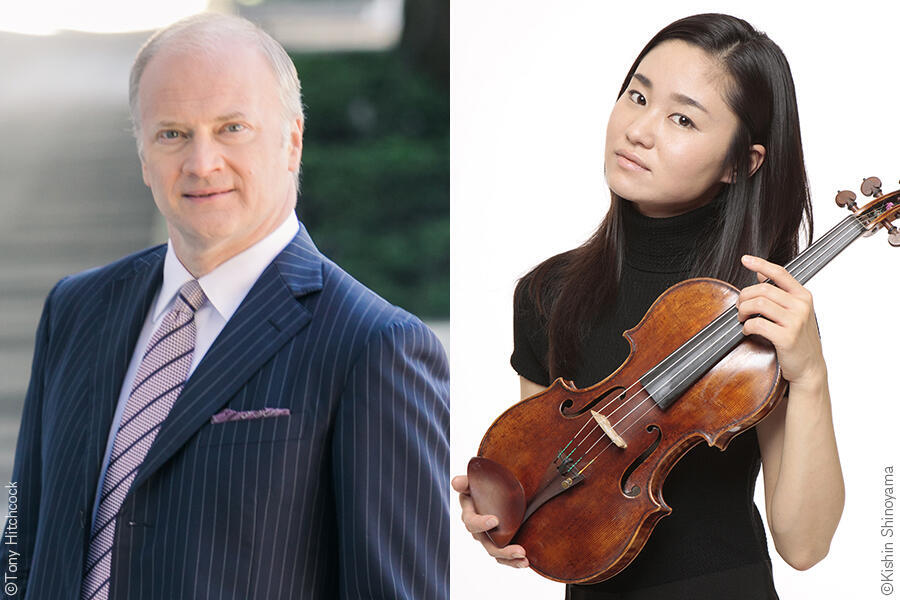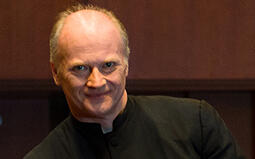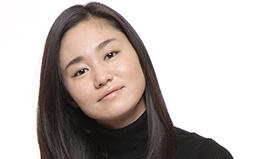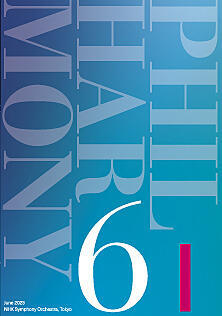- Home
- Concerts
- Subscription Concerts 2022-2023
- Program B
- No. 1988 Subscription (Program B)
Subscription Concerts 2022-2023Program B
No. 1988 Subscription (Program B)

Program
Bach / Respighi / Three Chorales
Respighi was a modern Italian composer whose Roman Trilogy (Fountains of Rome, Pines of Rome and Roman Festivals, 1915–1928) has fascinated orchestra fans. The elaborate scoring skills of the Bologna-born tone poet was honed in 1900 under Rimsky-Korsakov (1844–1908), a greatest orchestrator, while the younger man was working as a viola player in Saint Petersburg.
It was after the premieres of the Roman Trilogy that Respighi penned Three Chorales, orchestral arrangements of J. S. Bach’s three masterpieces for organ (for two manuals and pedal) each of which is a setting of a Protestant chorale tune. No. 1 is transcribed from Nun komm’der Heiden Heiland (Come, Savior of the Heathen) BWV659 of which Respighi transposed the mystique to a solemn string sound world. No. 2 is a brief adaptation, marked “scherzando (playfully),” of Meine Seel’ erhebet den Herren! (My Soul Magnifies the Lord) BWV648 where Respighi entrusts the chorale melody (derived from a Gregorian chant) to a trumpet. No. 3 is after Wachet auf, ruft uns die Stimme (Awake, the Voice is Calling Us) BWV645 which is based on the hopeful tenor aria from Bach’s own cantata BWV140. Respighi’s version is started by strings alone before the chorale tune enters with woodwinds. The texture becomes more colorful and thicker slowly to conclude with the brilliant brass support.
[Kumiko Nishi]
Respighi / Concerto gregoriano*
Respighi left us a vast catalogue containing original compositions inspired by early music as well as transcriptions of past works. He frequently used medieval church modes – famously in Pines of Rome –, partly because the singer Elsa Olivieri-Sangiacomo whom he married in 1919 was learned in Gregorian chant (a form of unaccompanied liturgical chant of the Catholic Church).
Concerto gregoriano (1921) lets the solo violinist turn his/her back on any hollow bravura so he/she leads the orchestra just like a cantor in church. The entire work is characterized by its use of church modes. The first movement, for example, opens with string chords in Aeolian mode (A/B/C/D/E/F/G-natural/A) before oboes give the principal theme in Dorian mode (A/B/C/D/E/F-sharp/G/A). After a cadenza by the soloist alone, the next movement begins seamlessly with the solo violin quoting Victimae paschali laudes (Praise the Paschal victim), a sequence (chanted hymn) for Easter Sunday. The jubilant finale is entitled “Alleluja”: the recurrent theme intoned by horns at the start then taken over by the solo violin resembles indeed the melody of the Gregorian chant Alleluia sung before Beatus vir, qui timet (Blessed is the man that fears the Lord) (Psalm 112:1).
[Kumiko Nishi]
Rakhmaninov / Symphony No. 1 D Minor Op. 13
In 1897, the Russian composer Rakhmaninov in his early twenties faced a disaster of the premiere of his new symphony in Saint Petersburg. He then suffered from deep depression and writer’s block for three years before restoring his confidence to complete the celebrated Piano Concerto No. 2. The symphony in question is none other than No. 1 Op. 13.
One theory says that the deciding factor in its fiasco is Alexander Glazunov who led the first performance. Though an able composer, he seemed not to have much ability for conducting nor respect for this symphony. Lambasted, it was since never heard during Rakhmaninov’s lifetime.
When he escaped from his motherland in the aftermath of the 1917 Revolution, the manuscript score of No. 1 was left there to be lost. After he died abroad, the parts used at the premiere were discovered in Leningrad. With the score reconstructed from them, the 1945 second performance in Moscow was received enthusiastically.
No. 1 is a “cyclic” work, as all the four movements are built of at least two common motivic/melodic elements. The first element is heralded by woodwinds at the symphony’s outset, as a swift triplet followed by a D note stressing D minor, the main key. The similar motives would open the three other movements without exception. The second element is typical of Rakhmaninov, for its first four notes are stemmed from the Dies irae (Day of Wrath) melody of the Catholic Mass for the Dead (this sinister melody is famously present in the composer’s many works). Strings disclose this cyclic element during the introduction of the opening movement, immediately before a clarinet imitates it as the first sonata theme. The next fairy movement, a scherzo, and the third slow movement packed with mellifluous tunes are succeeded by the D-major finale of which the overall mood comes to the fore with an elated flourish of trumpets. The slower valiant ending is spurred on by tam-tam (gong) used only during this movement and timpani.
[Kumiko Nishi]
Artists
 ConductorGianandrea Noseda
ConductorGianandrea Noseda
Italian conductor Gianandrea Noseda, born in Milan in 1964, is now serving as Music Director of the National Symphony Orchestra in Washington, D.C., sometimes dubbed the President’s orchestra, and as General Music Director of the Opernhaus Zürich having taken over from Fabio Luisi, thus he is active in both orchestral concerts and operas. He has continuously served in positions such as Principal Guest Conductor of the Mariinsky Theatre, Principal Conductor of the Cadaqués Orchestra, Spain, the BBC Philharmonic, and Music Director of Teatro Regio Torino. With the BBC Philharmonic, he has released numerous notable CDs of works of Respighi, Casella and Dallapiccola, and a disc of works of Russian composers he recorded with the London Symphony Orchestra, where he serves as Principal Guest Conductor, has also won high artistic acclaim. He actively takes up rarely performed works, discovers subtleties hidden in the work and fully draws out poetic and dramatic sentiments from them to reflect in the performances. We can only take off our hats to such a remarkable skill.
Since his first appearance with the NHK Symphony Orchestra in 2005, he has gradually built up good relations with the orchestra though his frequent visits. The programs he will conduct on this visit include the Japan premiere of Casella’s Symphonic Fragment from La donna serpente (The Serpent Lady), Symphony No.1, an ambitious work by Rakhmaninov whose 150th anniversary of birth falls on this year, and Shostakovich’s Symphony No. 8 — a highly attractive line-up of a variety of works which is typical of this conductor. We have great expectations for the enthusiastic collaboration of Maestro Noseda and the NHK Symphony Orchestra.
 ViolinSayaka Shoji*
ViolinSayaka Shoji*
Sayaka Shoji is a violinist who always has a high impact in concerts with fi rst class orchestras and conductors. She played Respighi’s Concerto Gregoriano at the BBC Proms in London in the summer of 2021, and Sibelius’ Violin Concerto at the Israel Philharmonic Orchestra’s season opening concerts under the baton of Lahav Shani in 2022.
She studied at the Chigiana Musical Academy in Siena, Italy with Uto Ughi and Riccardo Brengola, and with Shlomo Mintz in Israel, and with Zakhar Bron at the Hochschule für Musik und Tanz Köln, Germany, and became the youngest ever winner of the 46th Paganini Competition held in Genoa in 1999. Until now, she has played concertos numerous times under Zubin Mehta and Yuri Temirkanov while also under Gianandrea Noseda with the Orchestra dell’Academia Nazionale di Santa Cecilia in Rome.
She has an extensive discography. She recorded a collection of Beethoven Violin Sonatas with the Italian pianist Gianluca Cascioli, and in 2022, Mozart sonatas by gut strings and classical bows to follow the playing method of the classical period, together with Cascioli's fortepiano.
She has performed with NHK Symphony Orchestra several times. Her last appearance was in June 2018 when she performed Mendelssohn’s Concerto for Violin and Piano under Vladimir Ashkenazy and with pianist Vikingur Olafsson.
[Yoshimichi Okuda, music critic]
Download
Ticket
Program B
No. 1988 Subscription (Program B)
Suntory Hall
Google Map
Seating Chart
Single Tickets Release Date
Pre-sales for Subscribers:Wednesday, March 1, 2023
*about subscribers
Sale to General Public:Sunday, March 5, 2023
Price
| S | A | B | C | D | |
|---|---|---|---|---|---|
| Ordinary Ticket | 8,900 | 7,400 | 5,800 | 4,700 | 3,700 |
| Youth Ticket | 4,000 | 3,500 | 2,800 | 2,100 | 1,500 |
Seating chart Enlarge Print PDF
*tax included
*About Youth tickets (Available at N-Kyo Guide)
*Subscribers receive a 10% discount (Available at NHKSO WEB Ticket and N-Kyo Guide)
*For wheelchair-accessible seats, please refer to the N-Kyo Guide
Starting Dates of Ticket Sales
ANNUAL SUBSCRIPTION TICKETS Mon., July 18, 2022 11:00am
[For Subscribers: Thu., July 14, 2022 11:00am]
Youth Tickets
Youth Tickets are great options for those of 25 years old and younger
WEB Select 3 Plus
Choose three or more of your favorite concerts and get a discount on single tickets
*Only available at NHKSO WEB Ticket NHKSO WEB Ticket (Accesible from Japan only)
For further information and subscription application
N-Kyo Guide TEL:0570-02-9502


